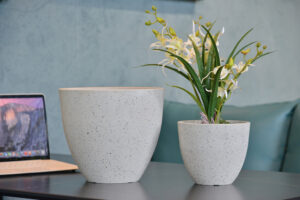What Light, Space, and Furniture Layout Factors Should Be Considered When Arranging Decorative Planters Indoors?
Arranging decorative planters indoors is a wonderful way to bring life, color, and style into your home. However, simply placing a plant pot wherever there's an empty spot might not be the most effective way to showcase your greenery and enhance your interior design. To truly create an appealing and harmonious indoor plant display, it's essential to consider factors like light, space, and furniture layout. For American homeowners looking to maximize the impact of their indoor plants, here’s a guide to these key considerations:
Considering Light Levels
The most crucial factor for plant placement is light. Different plants have varying light requirements, and placing them in the wrong spot can lead to poor growth or even death.1
- Identify Your Light Sources: Observe how natural light enters your home throughout the day. Note which areas receive direct sunlight, bright indirect light, low light, or no natural light at all.
- Match Plants to Light: Choose plants that are suitable for the light levels in the areas where you want to place them. For example, sun-loving plants like succulents or cacti need bright, direct light, while low-light tolerant plants like snake plants or ZZ plants can thrive in darker corners.
- Use Planters to Optimize Light: If a particular spot has insufficient light for your desired plant, consider using a taller planter to bring the plant closer to a window, or opt for a plant that tolerates lower light conditions.
- Consider Artificial Light: In areas with limited natural light, you might consider using grow lights to supplement the light your plants receive.2 You can incorporate these discreetly into your décor or even find planters with integrated grow lights.
Utilizing Space Effectively
The amount of available space and how you use it will also influence where and how you arrange your planters.
- Scale Your Planter to the Space: In small rooms, opt for smaller planters or hanging planters to avoid overwhelming the area. Larger, more spacious rooms can accommodate larger statement planters.
- Consider Traffic Flow: Place planters in locations where they won't obstruct walkways or doorways. Ensure there's enough room to move around comfortably.
- Empty Corners: Decorative planters are excellent for filling empty corners, adding life and visual interest to otherwise unused spaces.3 Tall planters with substantial plants work particularly well in these spots.
- Vertical Space: Utilize vertical space with wall-mounted planters, hanging baskets, or plant stands to add greenery without taking up valuable floor space. This is especially beneficial in smaller homes or apartments.
- Grouping Planters: Create visual interest by grouping planters of varying heights, sizes, and styles together. This can work well on a plant stand, a shelf, or even directly on the floor. Ensure there's enough space for each plant to receive adequate light and air circulation.
Integrating with Furniture Layout
The way you arrange your furniture can also guide your planter placement. Plants can be used to enhance existing layouts and create a more cohesive and inviting space.
- Balance and Symmetry: Use planters to create balance in a room. For example, place matching planters on either side of a sofa or fireplace to add symmetry.
- Defining Zones: Larger planters can be used to help define different zones within a larger open-plan space, such as separating a living area from a dining area.4
- Table Centerpieces: Smaller, low-profile planters with attractive foliage or small flowering plants can serve as beautiful and natural centerpieces on coffee tables, dining tables, or side tables.
- ** рядом with Seating Areas:** Place planters next to chairs or sofas to bring a touch of nature closer to your seating areas, creating a more relaxing and welcoming atmosphere.
- Filling Gaps and Odd Spaces: Use smaller planters to fill in awkward gaps or empty spots on bookshelves, mantels, or console tables.
Creating Visual Harmony
Ultimately, the goal is to create a visually appealing and harmonious arrangement of your planters and plants within your indoor space.
- Consider Color and Texture: Choose planters that complement the colors and textures of your furniture and other décor elements.
- Vary Plant Heights and Foliage: Select plants with different heights and foliage types to add visual interest and depth to your arrangements.
- Don't Overcrowd: Ensure that your plant displays don't feel cluttered. Allow each plant and planter to have its own space to shine.
By carefully considering light levels, utilizing your space effectively, and integrating your planters with your furniture layout, you can create stunning indoor plant displays that enhance the beauty and tranquility of your home.
Article copyright by GreenShip


Comments
Post a Comment